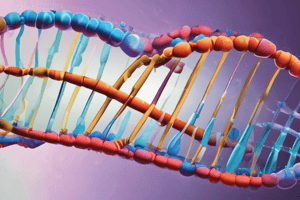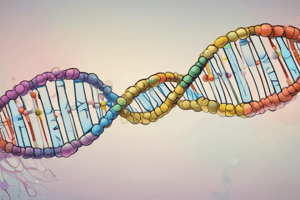Podcast
Questions and Answers
During DNA replication, which enzyme is responsible for unwinding the double helix structure?
During DNA replication, which enzyme is responsible for unwinding the double helix structure?
- Primase
- Ligase
- DNA Polymerase
- Helicase (correct)
Which of the following is the correct order of events in DNA replication?
Which of the following is the correct order of events in DNA replication?
- Primer addition → Unwinding of DNA → Elongation → Sealing of fragments
- Unwinding of DNA → Primer addition → Elongation → Sealing of fragments (correct)
- Elongation → Unwinding of DNA → Primer addition → Sealing of fragments
- Sealing of fragments → Elongation → Primer addition → Unwinding of DNA
What would be the mRNA sequence synthesized from the DNA template strand with the sequence 3'-TACGCTAGATT-5'?
What would be the mRNA sequence synthesized from the DNA template strand with the sequence 3'-TACGCTAGATT-5'?
- 5'-UA CGC UAG AUU-3'
- 5'-ATGCGATCTAA-3'
- 5'-TACGCTAGATT-3'
- 5'-AUGCGAUCUAA-3' (correct)
During translation, what role does tRNA play in protein synthesis?
During translation, what role does tRNA play in protein synthesis?
A mutation in a gene results in a protein with a drastically different sequence of amino acids. Which type of mutation is most likely to cause this?
A mutation in a gene results in a protein with a drastically different sequence of amino acids. Which type of mutation is most likely to cause this?
Which of the following best describes the function of a transcription factor?
Which of the following best describes the function of a transcription factor?
What distinguishes epigenetic changes from mutations in the DNA sequence?
What distinguishes epigenetic changes from mutations in the DNA sequence?
If a tRNA molecule with the anticodon 3'-UAC-5' binds to an mRNA molecule, what codon is it recognizing?
If a tRNA molecule with the anticodon 3'-UAC-5' binds to an mRNA molecule, what codon is it recognizing?
What is the role of the START codon (AUG) in translation?
What is the role of the START codon (AUG) in translation?
Which enzyme is responsible for synthesizing mRNA during transcription?
Which enzyme is responsible for synthesizing mRNA during transcription?
In the context of gene expression, what is the function of interfering RNA (RNAi) such as siRNA?
In the context of gene expression, what is the function of interfering RNA (RNAi) such as siRNA?
A point mutation occurs in a gene, changing a codon from UAC to UAA. What type of mutation is this, and what is its likely effect?
A point mutation occurs in a gene, changing a codon from UAC to UAA. What type of mutation is this, and what is its likely effect?
In bacteria, what is an operon, and how does it contribute to gene regulation?
In bacteria, what is an operon, and how does it contribute to gene regulation?
During DNA replication, why is the lagging strand synthesized in Okazaki fragments?
During DNA replication, why is the lagging strand synthesized in Okazaki fragments?
How do DNA methylation and histone modification contribute to epigenetic regulation of gene expression?
How do DNA methylation and histone modification contribute to epigenetic regulation of gene expression?
Flashcards
Nucleotide
Nucleotide
Building block of DNA, consisting of a sugar, phosphate group, and a nitrogenous base.
Chargaff's Rule
Chargaff's Rule
A=T and C=G; base pairing in DNA.
Antiparallel
Antiparallel
DNA strands running in opposite directions.
Helicase
Helicase
Signup and view all the flashcards
DNA Polymerase
DNA Polymerase
Signup and view all the flashcards
Ligase
Ligase
Signup and view all the flashcards
Leading Strand
Leading Strand
Signup and view all the flashcards
Lagging Strand
Lagging Strand
Signup and view all the flashcards
Okazaki Fragments
Okazaki Fragments
Signup and view all the flashcards
Transcription
Transcription
Signup and view all the flashcards
Translation
Translation
Signup and view all the flashcards
START Codon (AUG)
START Codon (AUG)
Signup and view all the flashcards
STOP Codons
STOP Codons
Signup and view all the flashcards
Point Mutations
Point Mutations
Signup and view all the flashcards
Frameshift Mutations
Frameshift Mutations
Signup and view all the flashcards
Study Notes
DNA Structure
- Nucleotide: Composed of a sugar (deoxyribose), a phosphate group, and a nitrogenous base (A, T, C, G)
- Chargaff's Rule: A = T and C = G, signifying complementary base pairing
- Antiparallel: The two strands of DNA run in opposite directions (5' to 3' vs 3' to 5')
Scientist Contributions
- Watson and Crick discovered the double-helix structure
- Rosalind Franklin contributed X-ray diffraction images to determine the structure
- Erwin Chargaff defined the base pairing rules (A = T, C = G)
DNA Replication
- Helicase unwinds the DNA helix
- DNA Polymerase adds complementary nucleotides to the growing strand
- Ligase seals the gaps between the Okazaki fragments
- Primase creates RNA primers to start replication
- Leading Strand is continuously synthesized in the 5' to 3' direction
- Lagging Strand is discontinuously synthesized in fragments (Okazaki fragments)
- Okazaki Fragments are short segments of DNA synthesized on the lagging strand
Transcription
- Occurs in the nucleus of eukaryotes
- RNA Polymerase binds to DNA at the promoter region
- RNA polymerase creates an mRNA strand using the DNA template
- mRNA is synthesized from 5' to 3'
- RNA Processing involves splicing the mRNA, and adding a cap and tail in eukaryotes
Translation
- Occurs in the ribosome (in the cytoplasm)
- mRNA is read in sets of three bases (codons)
- tRNA brings the corresponding amino acids to the ribosome
- The ribosome forms peptide bonds between amino acids to form a polypeptide chain
- Codon Chart/Wheel is used to match mRNA codons to amino acids
- START Codon: AUG, signals the beginning of translation
- STOP Codons: UAA, UAG, and UGA signal the end of translation
Gene Expression
- Gene expression regulation is vital for controlling which proteins are made, when, and in what amounts
Transcription Factors
- Positive Transcription Factors activate or enhance gene expression
- Negative Transcription Factors repress gene expression
- Binding Sites: Transcription factors bind to specific regions on the promoter of a gene to regulate its transcription
Interfering RNA
- Types: miRNA (microRNA) and siRNA (small interfering RNA)
- Function: Regulates gene expression by binding to mRNA and preventing translation or promoting mRNA degradation
Operons
- Definition: a group of genes regulated together under a single promoter
- Lac Operon is an operon in bacteria, regulated by the presence or absence of lactose
Epigenetics
- Definition: the study of changes in gene expression not caused by changes in DNA sequence
Examples of Epigenetic Markers
- DNA Methylation: The addition of methyl groups to DNA, typically represses gene expression
- Histone Modification: Histone proteins can be modified to either condense or relax chromatin, affecting gene accessibility
Mutations
- Frameshift Mutations are caused by insertions or deletions, which shift the reading frame of the codons and lead to a completely different protein
Point Mutations
- It is a change in a single nucleotide base
- Substitution occurs when one base is replaced by another (may or may not change the protein)
- Silent Mutation results in no change in the protein sequence
- Missense Mutation changes one amino acid in the protein sequence
- Nonsense Mutation changes a codon to a stop codon, leading to a truncated protein
- Mutations cause variations that are either beneficial, harmful, or neutral for an individual's survival and reproduction
Chromosomal Mutations
- Deletions: part of a chromosome is lost
- Duplications: part of a chromosome is repeated
- Inversions: part of a chromosome is reversed
- Translocations: parts of chromosomes are swapped
- Mutations contribute to genetic diversity within a population, which can lead to natural selection (positive, negative, or neutral effects)
Root Words
- Pro-: Before, in front of
- Poly-: Many, multiple
- Hist-: Tissue
- Anti-: Against
- Mut-: Change, alter
- Non-: Not
- Mis-: Wrong, incorrect
- Sub-: Under, below
- Trans-: Across, beyond
- -scribe, -script: Write, record
- Ex-: Out, away from
- -gen, -gene: Produce, create, origin
Studying That Suits You
Use AI to generate personalized quizzes and flashcards to suit your learning preferences.




